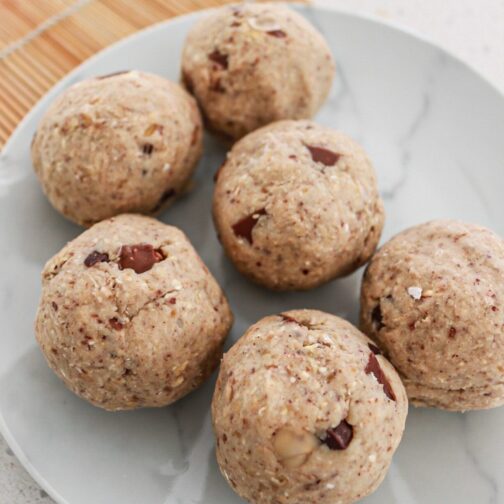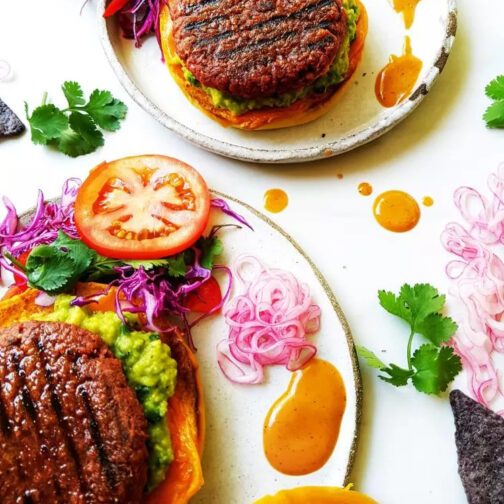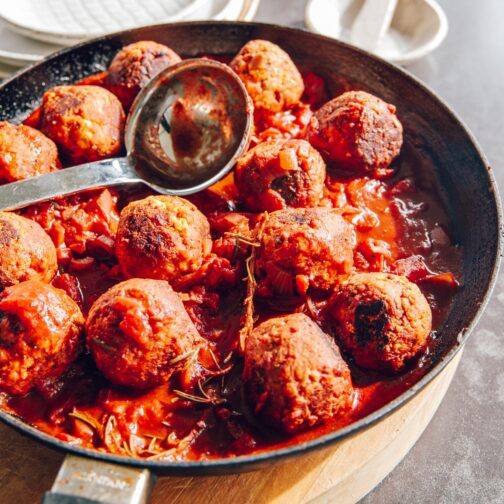
A whole food plant-based diet has the ability to prevent and even reverse some chronic diseases. Here we discuss the power of a well-implemented WFPB diet and how to get started.
When we talk about plant-based diets, we really mean plants only, so no meat, chicken, fish, eggs or dairy products. The whole foods part is not so black and white though and needs a little more explanation. When following a whole food, plant-based diet (WFPB), the food groups included are whole grains, legumes, fruits, vegetables and small quantities of nuts and seeds. Processed food is kept to a minimum and adheres to the adage, ‘nothing good removed, nothing bad added’.
A WFPB diet has a strong health ethos – we consider not just whether it’s a whole plant food but also whether it promotes good health. For example, coconut products are avoided because the high saturated fat content is not health promoting. However, unlike other vegan diets, a WFPB diet is defined more by what is included rather than by what is excluded. The key to successfully adopting a WFPB diet is to eat adequate, and even large, portions of ‘complex carbohydrates’ or ‘starches’. You want to get most of your calories from whole grains, legumes and root vegetables, with these making up at least half of your plate. You can load up the rest with salads and vegetables.
Following a WFPB diet is easy to sustain for many because of the improvements in wellbeing that people experience.
These include:
- Improved mood and energy
- Better skin tone and resolution of acne
- Improved sports performance
- Improved gut health
- Improved reproductive health
A key benefit of WFPB that can’t be overlooked is personal empowerment. You can take control of your health and protect yourself from numerous lifestyle diseases.
Your best defence against disease
While there are many areas of uncertainty in nutritional science, there is a core of knowledge that is not controversial.
Diets that include significant amounts of processed foods and animal products are a leading cause of modern diseases such as diabetes, heart disease and cancer.
Conversely, a healthy plant-based diet can provide improvements and even reverse these and other lifestyle-related diseases. If we consider all the published data on dietary treatment of disease, the known physiological mechanisms behind these diseases, and the experience of clinicians who treat them, they all point towards a plant-based diet that is low in fat and based on whole foods as a solution. Indeed, this is the only diet that has been proven to reverse coronary heart disease.
The Adventist Health Study 2 demonstrated a reduction in the risk of chronic disease with each step along the dietary spectrum from omnivore through to vegan. However, it should be noted that this and other studies also find some vegans still suffer from hypertension, diabetes and heart disease – conditions shown to be rare in populations with traditional diets that are mostly plant-based. The difference is that these populations ate minimally processed plant products, whereas a modern vegan diet can have more in common with the standard Western diet in terms of low dietary fibre content plus added fat, sugar and salt.
A whole food, plant-based diet has an impact on multiple diseases, whether for prevention, treatment or even reversal of disease. It also has a powerful therapeutic effect: a symphony of nutrients working on a multitude of bodily mechanisms that contribute to good health.
This is particularly powerful when compared to a pharmaceutical drug that inhibits a single chemical reaction. The effects of a WFPB diet is as much due to the inclusion of the many biologically active phytonutrients in whole plant foods as it is to the exclusion of harmful components in animal products and processed foods. Phytonutrients enhance normal physiological function, including:
- Reducing inflammation and oxidative damage
- Creating a healthy gut microbiome and gut function
- Reducing cholesterol and improving circulation
- Regulating oestrogen and other hormones
- Enhancing and balancing the immune system
- Regulating gene expression
A WFPB diet is a personally empowering strategy for staying healthy for as long as possible and has been shown to reverse many chronic diseases. I regularly see evidence of this at the 6-day immersion retreat I run – joint pain resolves, insulin doses plummet and general wellbeing improves in a very short period of time.
“A WFPB diet has a powerful therapeutic effect: a symphony of nutrients working on a multitude of bodily mechanisms that contribute to good health.”
WFPB dos and don’ts
Grains are an important component of a WFPB diet, and gluten free diets are easily accommodated by choosing grains other than wheat, barley and rye. Humans have been eating grains throughout time and research consistently observes better health outcomes for those who consume more whole grains. Intact whole grains such as brown rice, oats, quinoa, are better than flour products for weight loss and reversing insulin resistance. You want to keep any flour products as close to wholemeal as possible.
Avoid refined grains such as white rice, white pasta, processed gluten-free products and non-wholemeal flour. These have had good things removed – dietary fibre, iron and other nutrients, and phytonutrients including antioxidant polyphenols.
Fresh fruit is a health supporting whole food, rich in fibre, nutrients and water and low in calories, so great to include.
Dried fruit is still a whole food, but a lot more concentrated, so good for extra calories if you need them. While smoothies retain nutrients, they provide less satiety and more rapid sugar absorption, so chewing your food is the healthier option. A WFPB diet may include small amounts of partially processed foods, for example plant milks and tofu (which have had some fibre removed).
Sugar, sugary syrups and fruit juices are not whole foods, but if you choose to use them, try to keep this to small amounts.
A big adjustment for many who follow a WFPB diet is that all vegetable oils and margarines are excluded, even olive oil.
Oils are not whole foods and while there is debate as to whether oil can be part of a healthy diet, the consensus among plant-based nutrition experts is that oils are health-damaging foods. This has a lot to do with its composition. Oil has the maximum calorie content of any food and very few nutrients – zero fibre, zero protein, zero iron, zero calcium and so on. And even if oil were somehow healthy, it would displace a lot of food calories that should have provided fibre, nutrients and phytonutrients. Oils are not your friend if you are struggling to maintain your iron levels without supplements or you need more dietary fibre for better gut function. Further, joint pain and other health problems often only resolve when the last bit of oil is removed from the diet. Rest assured, while it may seem like a big change, it’s easy to prepare food without oil and there are plenty of resources to help you do it.
One more thing – plant protein supplements are unnecessary on a WFPB diet and have the same nutrient displacement issue as oil and sugar. Supplementing with isolated and concentrated nutrients is not a good insurance policy because excessive amounts of one nutrient can counteract the action of other nutrients. So, eat peas, not pea protein! (Vitamin B12 supplements are an exception here and are recommended for plant-based diets.)
Calorie density is key
Understanding calorie density is the key to managing weight whether you need to lose weight, maintain weight or bulk up. You do not need to practise portion control when you eat foods that are high in fibre, low in fat and calories, and naturally satiating.
Minimally processed grains, legumes, vegetables and fruits are satiating, resulting in unintended ‘calorie restriction’, which benefits many aspects of metabolic function. The high carbohydrate foods that have been demonised by low-carb ideology – potatoes, beans, brown rice and other whole grains – are moderately low calorie-density foods, with about half the calorie density of meat. You can healthfully eat large serves of phytonutrient-rich plants on a WFPB diet.
Be aware that nuts and seeds are naturally very high in fat and low in water, and consequently have at least five times the calorie density of basic starchy foods.
This makes them appealing to eat, but easy to overeat. Eating a lot of nuts and seeds can give you a very high ratio of omega-6 to omega-3 fats. For a healthier ratio include nuts and seeds that are higher in omega-3 such as flax and chia seeds. There is legitimate debate over how much high-fat whole plant foods to include in a healthy WFPB diet. However, it’s the more starch-based, low-fat end of the spectrum that has the runs on the board in terms of disease reversal studies, effective lifestyle programs and clinical experience.
Of course, part of the personal empowerment is that it’s up to you how plant-based and whole food you eat, but every step you take towards a WFPB diet will improve your health and wellbeing.
WFPB top tips
- Base your meals on large serves of whole grains, starchy vegetables and legumes
- Include plenty of vegetables, particularly cruciferous and leafy green vegetables
- Fresh fruit is not restricted, so eat up!
- Minimise foods that have had fibre removed and sugar, oil and salt added
- Learn to prepare food without oil
- Choose low oil options when eating out
- Practise moderation when eating nuts and seeds
- Drink plenty of water


























